Fassberg Seminar: Organomics – Reconstructing human organ development using single-cell transcriptomics
Fassberg Seminar
- Datum: 22.08.2017
- Uhrzeit: 11:00 - 12:00
- Vortragende(r): Prof. Dr. Barbara Treutlein
- Max Planck Institute for Evolutionary Anthropology, Leipzig
- Ort: Max-Planck-Institut für biophysikalische Chemie (MPIBPC)
- Raum: Large Seminar Room
- Gastgeber: Stefan W. Hell
- Kontakt: helena.miletic@mpibpc.mpg.de

Recent advances in stem cell biology have made it possible to grow in vitro three-dimensional (3D) human organoids that model human development. We are using these organoid systems in combination with single-cell (sc) genomic methods to understand molecular mechanisms underlying human organ development and disease.
First, we use scRNA-seq to dissect and compare cell composition and lineage relationships in human cerebral organoids and fetal neocortex. We identify cells in the cerebral organoids that derived from regions resembling the fetal neocortex and find that these cells use gene expression programs remarkably similar to those of the fetal tissue. We then apply our approach to cerebral organoids derived from patients with brain malformations to identify molecular mechanisms underlying these neurodevelopmental disorders. Second, we dissect 3D liver organoids generated by reconstituting hepatic, stromal, and endothelial cell interactions occurring during liver bud (LB) development. We use scRNA-seq to compare hepatocyte-like lineage progression from pluripotency in 2D culture and 3D LB organoids and find that organoid hepatoblasts diverge from the 2D lineage, and express epithelial migration signatures characteristic of organ budding. We benchmark 3D LB organoids against fetal and adult human liver, and find a striking correspondence between the LB organoid and fetal liver cells. We use network analysis to predict autocrine and paracrine signaling in LBs, and predict inter-lineage communication involved in LB vascularization and self-organization. In summary, our molecular dissection of human organoid development provides an approach to systematically analyze and improve tissue engineering and illuminates previously inaccessible aspects of human organ development.
First, we use scRNA-seq to dissect and compare cell composition and lineage relationships in human cerebral organoids and fetal neocortex. We identify cells in the cerebral organoids that derived from regions resembling the fetal neocortex and find that these cells use gene expression programs remarkably similar to those of the fetal tissue. We then apply our approach to cerebral organoids derived from patients with brain malformations to identify molecular mechanisms underlying these neurodevelopmental disorders. Second, we dissect 3D liver organoids generated by reconstituting hepatic, stromal, and endothelial cell interactions occurring during liver bud (LB) development. We use scRNA-seq to compare hepatocyte-like lineage progression from pluripotency in 2D culture and 3D LB organoids and find that organoid hepatoblasts diverge from the 2D lineage, and express epithelial migration signatures characteristic of organ budding. We benchmark 3D LB organoids against fetal and adult human liver, and find a striking correspondence between the LB organoid and fetal liver cells. We use network analysis to predict autocrine and paracrine signaling in LBs, and predict inter-lineage communication involved in LB vascularization and self-organization. In summary, our molecular dissection of human organoid development provides an approach to systematically analyze and improve tissue engineering and illuminates previously inaccessible aspects of human organ development.